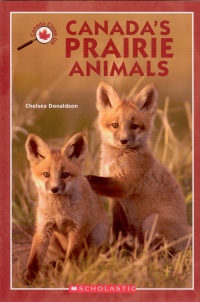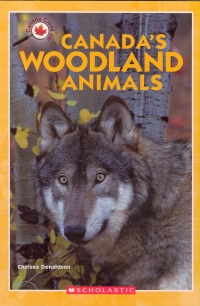| ________________
CM . . .
. Volume XV Number 14. . . .March 6, 2009 
 |
Canada's Prairie Animals. (Canada Close Up).
Chelsea Donaldson.
Toronto, ON: Scholastic Canada, 2007.
44 pp., pbk., $6.99.
ISBN 978-0-439-93666-8.
Subject Heading:
Prairie animals-Canada-Juvenile literature.
Grades 1-5 / Ages 6-10.
Review by Renée Englot.
*** /4
|
| |
|
 |
Canada's Woodland Animals. (Canada Close Up).
Chelsea Donaldson.
Toronto, ON: Scholastic Canada, 2006.
44 pp., pbk., $6.99.
ISBN 0-439-94677-8.
Subject Heading:
Forest animals-Canada-Juvenile literature.
Grades 1-5 / Ages 6-10.
Review by Renée Englot.
*** /4
|
| |
|

excerpt:
Burrowing owls are small - about the size of a robin. Their small size allows them to fit easily into the ready-made burrows of other animals.
When a pair of owls find a burrow they like, they use their wings, beaks and feet to make it bigger. Then they plaster the walls with feathers, leaves and dung.
Scientists aren't sure why they do this. It could be to attract dung beetles. YUM! Or perhaps it helps to hide their scent from predators. It could be to strengthen the walls to keep them from collapsing. Or maybe it makes the burrow warmer so the eggs will hatch sooner. (From Canada's Prairie Animals.)
Canada's Prairie Animals and Canada's Woodland Animals are part of the "Canada Close Up" series by Chelsea Donaldson. Other titles in the series include Canada's Arctic Animals, Canada's Wetland Animals, Canada's Mountain Animals and Canada's Coastal Animals. All follow the same pattern and offer consistent quality.
The books are very readable. The casual, conversational tone makes the text inviting. The short sentences and simple vocabulary make the information accessible. New words such as hibernaculum are introduced with a definition given in context and with a pronunciation guide. The numerous colour photos illustrating the pages make the work visually appealing.
Donaldson has a good sense of what her young audience needs and likes. She makes frequent use of comparison, asks the reader to put himself in the animal's position, poses questions, points out the odd gross or scary fact, and utilizes humour. Donaldson also makes a point of highlighting behaviours and habits that scientists do not yet understand. I appreciate this inclusion. We don't have all the answers. Animals have some secrets of their own. The inclusion of uncertainty also points young readers to the fact that scientists are not people with all the answers; they're people who ask questions and try to figure out the answers.
In Canada's Prairie Animals, young readers learn about the Richardson's ground squirrel, the monarch butterfly, the badger, the burrowing owl, the coyote, the red fox, the pronghorn, the red-tailed hawk, and the bison. Surprisingly, there's also a chapter about the northern prairie skink, a desert animal. Its inclusion might cause confusion about this being a typical prairie animal. The Carberry Sandhills are a tiny part of the prairies in Manitoba. Still it's interesting for readers to learn that there is a desert on the Canadian prairies.
In Canada's Woodland Animals, Donaldson covers the wolf, the black bear, the lynx, the white-tailed deer, the skunk, the porcupine, the chipmunk, the pileated woodpecker, the little brown bat and the red snake.
Each book begins with an introduction to the region, including a map of Canada which indicates the location(s) of this region within Canada. In Canada's Woodland Animals, the map is colour coded according to type of forest. Both books also have conclusions, although only Canada's Woodland Animals refers to the conclusion in the table of contents. Unfortunately when the reader turns the page and comes upon the conclusion, there is nothing to indicate the switch from talking about one specific species to talking about the animals of the region in general. I thought I'd missed a page.
The information Donaldson provides is more anecdotal than factual. Reading the chapter on a given species might not give readers a clear picture of basic information such as size, habitat, dietary habits, or range. Instead, readers will hear about some of the more interesting characteristics of the animal. While the books aren't suited to those on a fact-finding research mission, they may serve to pique interest in learning more about an animal. At the least, they should provide an interesting read.
Recommended.
Renée Englot is a former junior high school teacher now working as a professional storyteller in school settings. She holds a Master of Arts in Children's Literature.

To comment
on this title or this review, send mail to cm@umanitoba.ca.
Copyright © the Manitoba Library Association. Reproduction for personal
use is permitted only if this copyright notice is maintained. Any
other reproduction is prohibited without permission.
NEXT REVIEW |
TABLE OF CONTENTS FOR THIS ISSUE
- March 6, 2009.
AUTHORS |
TITLES |
MEDIA REVIEWS |
PROFILES |
BACK ISSUES |
SEARCH |
CMARCHIVE |
HOME |

